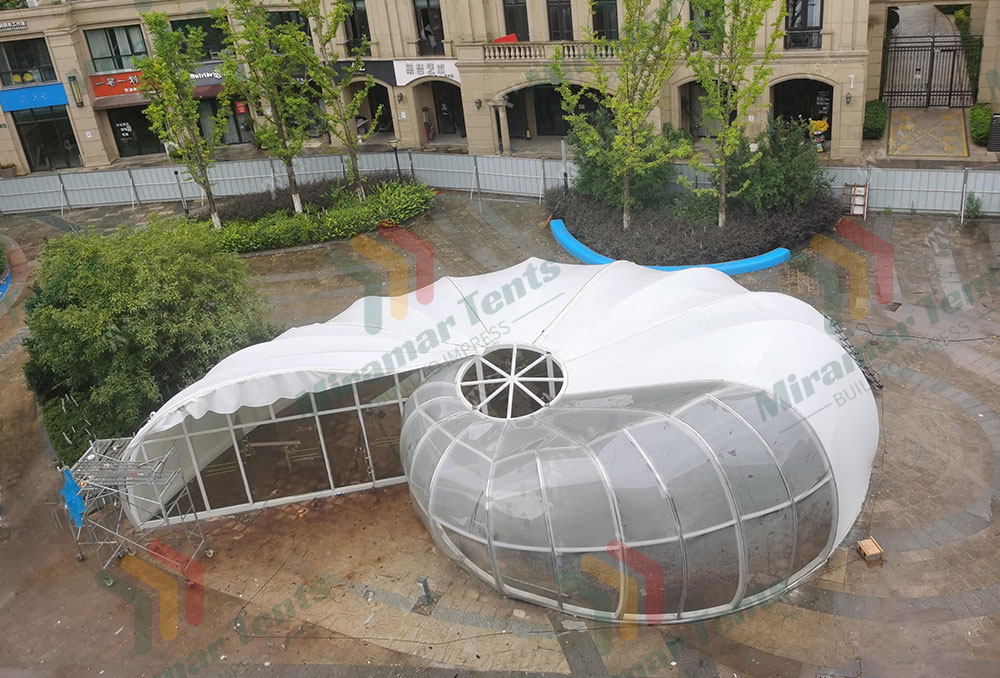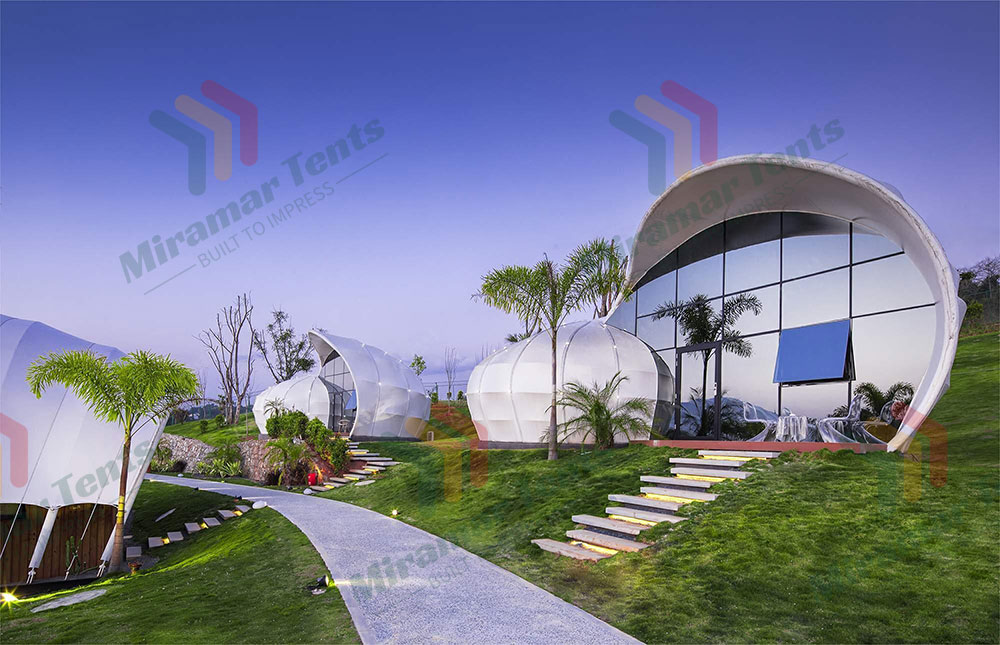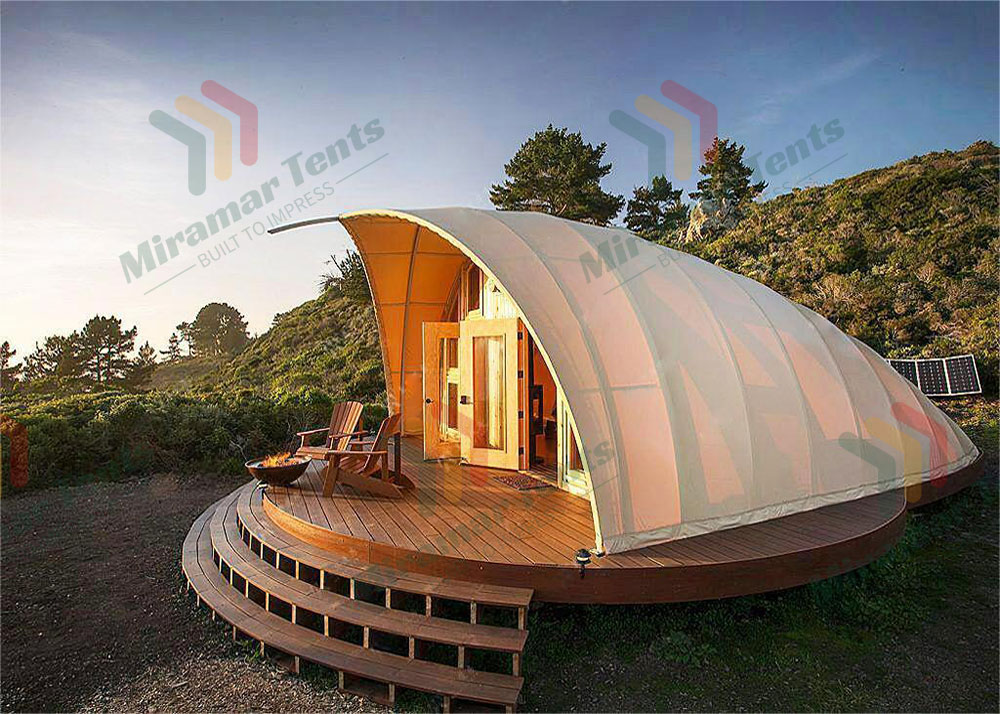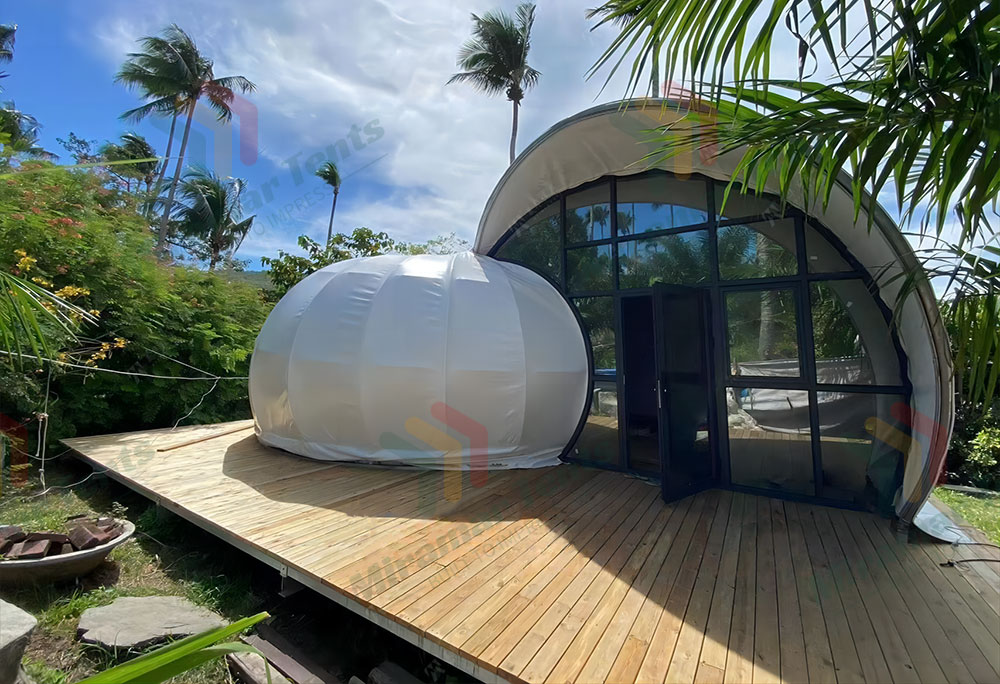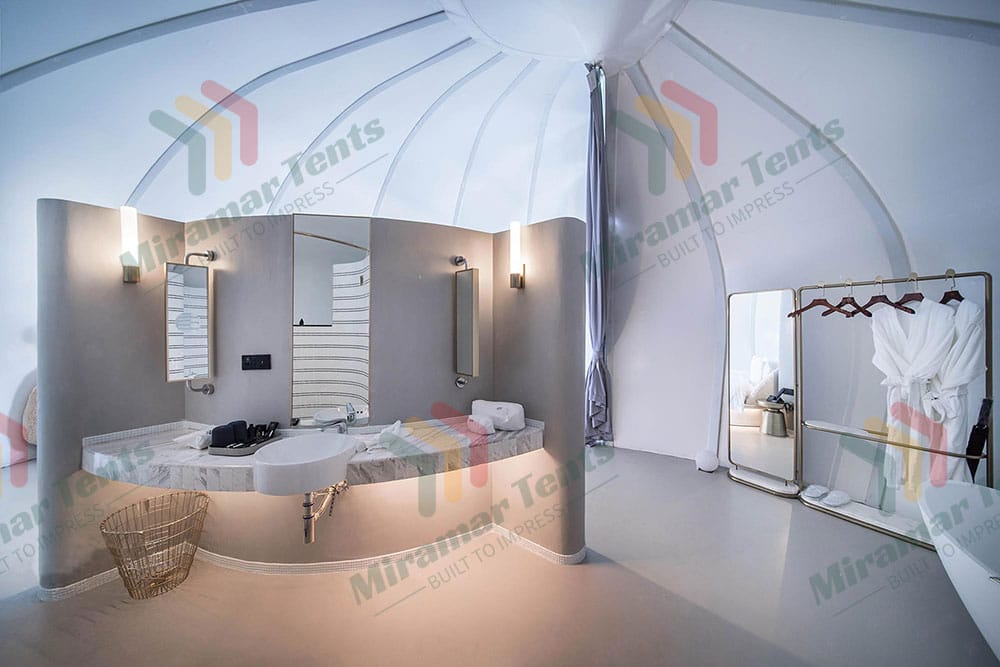Welcome to glamping, where luxury meets the outdoors! At Miramar Tents, we know how important it is to follow safety rules for our fancy outdoor tents and structures. In this guide, we’ll talk about all the ways we keep glamping safe and fun. We’ll cover things like building strong tents, preventing fires, dealing with weather, and following local rules. This information will help both the people who run glamping sites and the guests who stay in them feel safe during their outdoor adventures.
Key Takeaways
| Aspect | Key Considerations |
|---|---|
| Building Codes | Follow international and local rules, get needed permits |
| Structural Integrity | Use strong materials, make sure structures can hold enough weight |
| Fire Safety | Use materials that don’t burn easily, install fire prevention systems |
| Weather Resistance | Design for strong winds, protect against water and dampness |
| Environmental Impact | Disturb nature as little as possible, use eco-friendly materials |
| Accessibility | Make sure everyone can use the accommodations, including people with disabilities |
| Maintenance | Check and fix things regularly to keep everything safe |
Key Safety Considerations for Glamping Structures
Here are the main safety things every glamping operator should think about:
Building Codes and Safety Regulations for Luxury Outdoor Accommodations
- Follow local zoning laws and land use rules
- Get necessary permits (e.g., Special Use, Conditional Use, Building)
- Follow fire safety standards for outdoor structures
- Ensure proper electrical safety for outdoor installations
- Install good ventilation and air quality systems
- Meet accessibility requirements for people with disabilities
- Use materials that don’t burn easily for tents and fabric structures
- Install proper bathrooms and follow health rules
- Check structures regularly to make sure they’re still strong
- Make sure outdoor structures can handle bad weather
- Follow rules to protect the environment when building
- Keep good records of safety checks and inspections
- Have clear emergency plans and signs
- Make sure trash is handled and disposed of properly
- Follow local rules about noise and light pollution
These key points are the basics of running a safe glamping site. We’ll talk about each of these areas in more detail throughout this article. We’ll give you tips and advice on how to make your glamping structures safe. By taking care of these important things, you’ll be on your way to creating a secure and fun environment for your guests while lowering risks.
Building Codes and Regulations for Engineered Glamping Structures
Understanding and following building codes and regulations is really important for making sure your glamping structures are safe and legal. While specific rules might be different depending on where you are, there are general principles that apply to most engineered outdoor accommodations. Following these regulations is not only required by law but also essential for providing a safe and reliable glamping experience for your guests.
International and National Building Code Compliance
Glamping structures, even though they’re unique, have to follow many of the same building codes as regular buildings. These codes are made to ensure minimum standards for safety, health, and general welfare. Key areas include:
- Structural design: Making sure the structure can stand up to expected weights, including wind and snow.
- Fire safety: Putting in proper fire resistance and ways to escape. This includes using materials that don’t burn easily, installing smoke detectors, and making clear escape routes.
- Accessibility: Providing accommodations that people with disabilities can use.
- Energy efficiency: Meeting standards for insulation and energy use.
- Plumbing and electrical systems: Making sure utilities are installed safely and correctly.
At Miramar Tents, we design our structures with these international standards in mind. For example, our Glamping Seashell Tent Hotel is built to meet tough structural requirements while still looking cool. Its unique shell-like design not only looks eye-catching but also helps it stand up to different environmental stresses.
Local Zoning and Permit Requirements
Besides national and international codes, glamping operators also need to follow local zoning laws and get necessary permits. This process usually involves:
- Zoning compliance: Making sure your glamping site is allowed in the area.
- Building permits: Getting approval to build or set up structures.
- Health department approvals: Especially important for structures with plumbing or food service.
- Environmental impact assessments: Showing that you won’t harm the surrounding ecosystem too much.
- Occupancy permits: Getting final approval for guests to use the structures after everything is built and checked.
- Special rules for temporary structures: Some places might have specific rules for seasonal or temporary installations.
Dealing with these requirements can be complicated, but it’s a necessary step in setting up a legal and safe glamping operation. Our team at Miramar Tents has experience working with various regulatory bodies, and we can help guide you through meeting local requirements. We know that each location has its own challenges, and we’re committed to helping our clients find solutions that satisfy both the rules and what guests expect.
For a better understanding of how we’ve successfully navigated these regulations in real situations, check out our case studies. They provide valuable insights into the process of setting up compliant glamping structures in various locations, showing how we’ve overcome specific challenges and come up with innovative solutions to meet both safety standards and guest comfort requirements.
Structural Integrity and Material Safety
The foundation of any safe glamping structure is its structural integrity and the safety of the materials used to build it. This is where engineering know-how meets creative design to create structures that are both secure and luxurious. At Miramar Tents, we focus strongly on using high-quality materials and advanced engineering principles to ensure our glamping structures can handle outdoor use while providing a safe and comfortable environment for guests.
Frame and Support System Requirements
The frame and support system of a glamping structure must be engineered to withstand various stresses, including:
- Dead loads: The weight of the structure itself and permanent fixtures.
- Live loads: The weight of people, furniture, and temporary items.
- Environmental loads: Wind, snow, and earthquake forces.
- Thermal loads: Expansion and contraction due to temperature changes.
- Dynamic loads: Forces from movement or vibration.
Our Glamping Shell Pods, for instance, use a strong aluminum alloy (6061/T6) frame that provides exceptional strength while still being lightweight. This material choice allows for a robust structure that can be easily transported and assembled, making it ideal for various glamping scenarios.
Key considerations for frame and support systems include:
- Material selection: Choosing materials that don’t rust and last a long time.
- Load calculations: Making sure the structure can support all expected weights.
- Connection design: Properly joining structural elements to spread forces evenly.
- Foundation requirements: Appropriate anchoring to the ground or platform.
- Flexibility and adaptability: Designing structures that can be adjusted for different environmental conditions or seasonal changes.
- Ease of assembly and disassembly: Particularly important for temporary or seasonal glamping operations.
Fabric and Membrane Safety Standards
For many glamping structures, including our innovative designs at Miramar Tents, fabric and membrane materials play a crucial role. These materials must meet strict safety standards, including:
- Tensile strength: Ability to stretch without tearing.
- UV resistance: Protection against sun damage.
- Mold and mildew resistance: Preventing growth of harmful microorganisms.
- Chemical safety: Ensuring materials are free from harmful chemicals.
- Fire resistance: Meeting or exceeding fire safety standards.
- Tear resistance: Ability to withstand punctures or tears.
- Weather resistance: Capability to withstand rain, wind, and temperature changes.
Our Glamping Shell Pods, for example, use flame-retardant PVC fabric that not only meets these safety standards but also provides excellent weather resistance and durability. This material choice ensures that our structures can withstand various environmental challenges while maintaining a safe and comfortable interior environment for guests.
Fire Safety and Flame Retardancy
Fire safety is super important for any accommodation, including glamping structures. Because these outdoor structures are unique, we need to pay special attention to preventing and dealing with fires. At Miramar Tents, we make fire safety a top priority in all our designs, putting in place comprehensive measures to protect guests and property.
Fire-resistant Materials and Treatments
Using fire-resistant materials is key to ensuring the safety of glamping structures. At Miramar Tents, we carefully choose materials that meet or exceed fire safety standards. Key considerations include:
- Fabric flame retardancy: All fabrics used in our structures are treated to slow down fire spread.
- Structural material fire resistance: The aluminum alloy frames we use naturally resist fire.
- Interior furnishings: We recommend using fire-resistant bedding, curtains, and other interior items.
- Insulation materials: When we use insulation, we choose options that are good for temperature control and meet fire safety standards.
- Electrical components: All wiring and electrical fixtures are chosen and installed with fire safety in mind.
It’s important to remember that fire-resistant treatments might need to be reapplied every so often, especially for fabric parts exposed to weather. Regular checks and maintenance are crucial to keeping fire safety standards high. We suggest setting up a schedule to test and retreat materials as needed, usually once a year or as the manufacturer recommends.
Emergency Exits and Fire Suppression Systems
Designing good emergency exits and including fire suppression systems are vital parts of fire safety in glamping structures. Our designs include the following features:
- Multiple exits: Even in smaller structures, we make sure there are at least two ways out.
- Clear pathways: All exits are designed to be easily accessible and free from obstacles.
- Emergency lighting: Battery-powered lights are installed to light up exit paths if the power goes out.
- Fire extinguishers: We recommend placing fire extinguishers in easy-to-reach locations within each structure.
- Smoke detectors: Battery-operated smoke detectors are essential in all glamping accommodations.
- Sprinkler systems: For larger or more permanent structures, automatic sprinkler systems might be necessary.
- Fire-resistant curtains or dividers: In multi-room structures, using fire-resistant dividers can help stop fire and smoke from spreading.
- External fire safety equipment: For glamping sites, we recommend having additional firefighting equipment accessible, especially in remote locations.
Along with these physical measures, it’s crucial to have a well-developed fire safety plan. This should include regular staff training, clear communication of fire safety rules to guests, periodic fire drills, and working with local fire departments for inspections and emergency response planning. This comprehensive approach ensures that both prevention and response measures are in place to protect guests and property if a fire happens.
Weather Resistance and Environmental Considerations
Being able to handle different weather conditions is super important for the safety and long life of glamping structures. At Miramar Tents, we design our products to work well in many different environments, making sure guests are comfortable and the structures stay strong no matter the weather. This focus on weather resistance not only makes things safer but also helps guests have a great experience, allowing for year-round operations in many places.
Wind Load Requirements
Wind resistance is a critical factor in designing outdoor structures. Our engineered glamping solutions are built to handle strong winds:
- Aerodynamic design: The unique shell-like shape of our structures helps reduce wind resistance.
- Strong anchoring systems: We provide special anchoring solutions for different ground types and wind conditions.
- Flexible materials: We use flexible, strong fabrics that can bend instead of break in strong winds.
- Wind speed ratings: Each of our structures is rated for specific maximum wind speeds.
- Reinforced stress points: Areas that experience the highest wind loads are made extra strong.
- Dynamic load testing: Our designs go through tough testing to make sure they can handle changing wind loads.
It’s important to note that while our structures are designed for high wind resistance, during extreme weather events, it might still be necessary to temporarily evacuate for guest safety. We provide clear guidelines on wind speed limits and recommend that operators develop thorough severe weather protocols.
Water and Moisture Protection
Keeping guests dry and comfortable is essential in any outdoor accommodation. Our glamping structures include several features to ensure excellent water and moisture protection:
- Water-resistant fabrics: The PVC fabrics used in our structures are highly water-resistant, preventing leaks and moisture from getting in.
- Elevated flooring: Many of our designs include raised floors to keep ground moisture out of the living space.
- Proper drainage: The shape and design of our structures help water run off efficiently.
- Ventilation systems: Good airflow helps prevent condensation and mold growth inside the structures.
- Sealed seams and joints: All connections and seams in our structures are carefully sealed to keep water out.
- Weatherproof entrances: Entrances are designed with overhangs or awnings to provide extra protection from rain.
Environmental considerations go beyond just weather resistance. We also focus on using sustainable materials, incorporating energy-efficient design features, and ensuring our structures have minimal impact on the site and can be easily put up and taken down. This approach not only makes our products more eco-friendly but also allows for greater flexibility in where and when glamping operations can be set up.
Conclusion: Ensuring Safe and Compliant Glamping Experiences
As we’ve explored in this article, ensuring safety and compliance in engineered glamping structures involves a comprehensive approach. This covers everything from building codes and structural integrity to fire safety and environmental considerations. At Miramar Tents, we’re committed to providing luxurious outdoor accommodations that not only meet but exceed safety standards, allowing guests to fully enjoy nature without worrying about comfort or security.
By prioritizing safety in every aspect of our designs, from the Glamping Seashell Tent Hotel to our innovative Glamping Shell Pods, we ensure that guests can fully immerse themselves in the beauty of nature while staying safe and comfortable. Our structures are engineered to withstand various environmental challenges while providing a luxurious experience for guests.
Remember, while this guide provides a comprehensive overview of safety standards and compliance requirements, it’s always important to check with local authorities and professional engineers when setting up glamping structures. Each location has its own unique challenges and rules, and a tailored approach is often necessary to ensure full compliance and optimal safety.
With the right approach to safety and compliance, we can continue to push the boundaries of luxury outdoor accommodations while ensuring the well-being of every guest. At Miramar Tents, we’re dedicated to supporting glamping operators in creating unforgettable experiences that are as safe as they are spectacular. By combining innovative design, rigorous safety standards, and a deep respect for the natural environment, we’re helping to shape the future of sustainable, luxurious outdoor accommodations.

